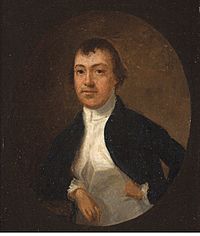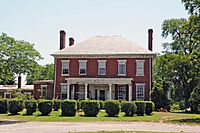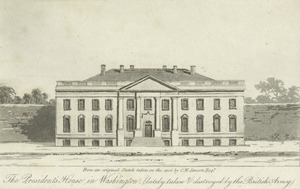Martha Jefferson Randolph facts for kids
Quick facts for kids
Martha Jefferson Randolph
|
|
|---|---|
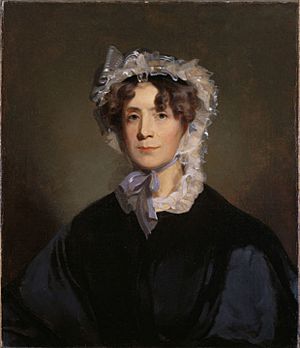
Thomas Sully, Martha Jefferson Randolph, 1836, oil, Thomas Jefferson Foundation
|
|
| Acting First Lady of the United States | |
| In role March 4, 1801 – March 4, 1809 |
|
| President | Thomas Jefferson |
| Preceded by | Abigail Adams |
| Succeeded by | Dolley Madison |
| First Lady of Virginia | |
| In role December 1, 1819 – December 1, 1822 |
|
| Governor | Thomas Mann Randolph Jr. |
| Preceded by | Ann Barraud Taylor Preston |
| Succeeded by | Susanna Lawson Pleasants |
| Personal details | |
| Born |
Martha Jefferson
September 27, 1772 Monticello, Virginia, British America |
| Died | October 10, 1836 (aged 64) Albemarle County, Virginia, U.S. |
| Resting place | Monticello Cemetery |
| Spouse | |
| Children | 12, including Thomas and Ellen, Cornelia, George |
| Parents | |
| Signature | |
Martha "Patsy" Randolph (born Jefferson; September 27, 1772 – October 10, 1836) was the oldest daughter of Thomas Jefferson. He was the third president of the United States. Her mother was Martha Wayles Skelton Jefferson. Martha was born at Monticello, her family's home in Virginia.
Martha's mother died when Martha was almost 10 years old. Only two of her five younger brothers and sisters were still alive. Her father made sure she got a very good education. She learned to speak four languages. She was greatly shaped by her time at a special school in Paris. By 1804, she was the only one of her parents' children still alive. She was the only one to live past age 25.
Martha Jefferson married Thomas Mann Randolph Jr.. He was a politician who became the governor of Virginia (1819–1822). This made Martha the First Lady of Virginia. They had twelve children together.
Martha helped manage the family farms, Varina and Edge Hill, with her husband. She also helped her father manage Monticello. She wrote letters to her father often when they were apart. She gave him emotional support, which helped him through his busy political life. She also lived with him at the White House. There, she served as an informal First Lady.
After her father's time in the White House, Martha and her children lived at Monticello. They took care of her father. Because of money problems, the Randolphs sold Varina. They lost Edge Hill farm in 1825. When her father died in 1826, Martha inherited Monticello. She also inherited his many debts. Many of the enslaved people at Monticello were sold to help pay off these debts.
Contents
Martha's Early Life and Education
Growing Up in Virginia
Martha Jefferson was born on September 27, 1772, at Monticello. This was her father's large estate in Virginia. Her parents were Thomas Jefferson and Martha Wayles Skelton. Martha was their first child. Her parents had six children during their ten-year marriage. Only Martha and her sister Mary lived past a few years old. As a young child, Martha saw her mother struggle with difficult pregnancies. Both parents also grieved the deaths of four young children.
The family lived a comfortable life. Martha first learned at home. She also took dance lessons. When she was seven, her father became the governor of Virginia. The family first lived in Williamsburg. Then they moved to Richmond in 1780. British troops came to Richmond in 1781. The Jeffersons escaped to their country home, Poplar Forest.
Martha was almost 10 when her mother died on September 6, 1782. This was four months after her parents' last child was born. Martha later wrote about this sad time. She said she was always with her father during his grief. She saw him have "many a violent burst of grief."
School in Philadelphia
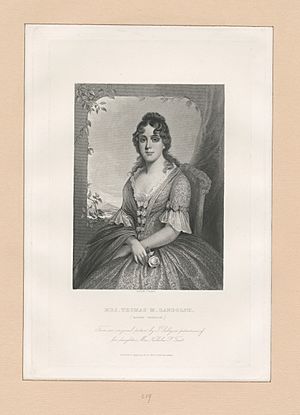
Martha went to Philadelphia with her father in 1782. She went again in 1783. Her father was representing Virginia at the Congress of the Confederation. Philadelphia was the biggest city in America then. It was a center for new ideas.
Martha's father did not believe in public schools for girls. But he made sure his daughter got a private education. From December 1782 to May 1784, she lived with a family. She studied French, dancing, drawing, and music. Her father gave her tutors strict daily plans. He wanted her to become a respected and smart lady. He especially focused on cleanliness and good manners. He wanted her to have the image of a proper lady. Meanwhile, her father worked in Philadelphia. He waited for Congress to send him to France.
Studying in Paris
Martha and her father traveled to Boston with James Hemings. They sailed to Paris on July 5, 1784. They arrived in France on August 6, 1784. Martha lived in Paris from age 12 to 17. Her father was the U.S. Minister to France there. In October 1784, her youngest sister, Lucy, died.
Jefferson enrolled Martha at the Pentemont Abbey. This was a special boarding school. He was told that Protestant students did not have to take religious classes. At this school, Martha learned arithmetic, geography, world history, and Latin. She also studied music and drawing. She was greatly influenced by her four years at this school. Her classmates were daughters of important French families. They showed her what "female intelligence" and "energy" looked like. She also saw the "colorful Catholic ceremonies." This experience helped her have smart and fun conversations. It also made her think about how she would educate her own children one day.
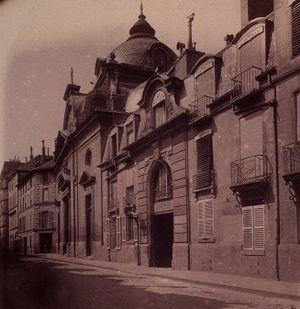
When she socialized at the Abbey, she learned about women's role in politics. She also learned about the disagreements leading to the French Revolution. Her father had helped write the Declaration of the Rights of Man in France. Martha said her time in France was "the brightest part of a life much shaded & saddened by care & sorrows."
Her younger sister Mary joined her at the school in July 1787. Martha and Mary got sick with typhus in the winter of 1788. They lived with their father until they got better. They went back to the school in the spring of 1789. Martha then said she wanted to convert to Catholicism. She also said she was thinking about becoming a nun. Jefferson quickly took her and Mary out of the school. During her studies, Martha learned to speak four languages.
Martha met smart and modern European women. She also met world leaders in France. She enjoyed a social life that included dances and concerts. She saw the "collective power of French women." They marched to the king's palace at Versailles. They forced the royal family to return to Paris. This happened with the help of the Marquis de Lafayette, a friend of the Jefferson family. In September 1789, after the French Revolution began, Thomas Jefferson, his daughters, and James and Sally Hemings sailed for America. They arrived in 1790.
Martha's Marriage and Family Life
On February 23, 1790, Martha married Thomas Mann Randolph Jr. at Monticello. She was 17 years old. He was a farmer and her third cousin. He was also a descendant of Pocahontas.
Soon after their wedding, her father gave them eight enslaved people as a wedding gift. This included Molly Hemings. Critta Hemings, a sister of Sally Hemings, helped Martha care for her children for many years.
The couple first lived at Thomas's farm, Varina. Martha had twelve children there. She had more children than any other daughter of a U.S. President. Unlike her parents and sister, most of her children lived to adulthood. Eleven of the Randolphs' children survived:
- Ann Cary Randolph (1791–1826)
- Thomas Jefferson Randolph (1792–1875)
- Ellen Wayles Randolph (1794–1795), died young.
- Ellen Wayles Randolph (1796–1876), named after her deceased sister.
- Cornelia Jefferson Randolph (1799–1871). She started a school and translated a book about gardening.
- Virginia Jefferson Randolph (1801–1881)
- Mary Jefferson Randolph (1803–1876). She helped manage her brother's household.
- James Madison Randolph (1806–1834), born at the White House.
- Benjamin Franklin Randolph (1808–1871)
- Meriwether Lewis Randolph (1810–1837)
- Septimia Anne Randolph (1814–1887)
- George Wythe Randolph (1818–1867), who later became Secretary of War for the Confederate States of America.
Life at Varina, Monticello, and Edge Hill
Martha managed the households at Varina and her father's estate at Monticello in the 1790s. She taught her children at home. She felt more loyalty to her father than to her husband. Martha's relationship with her husband was difficult. This was partly because she stayed so close to her father. Also, her husband's family had money problems and disagreements.
For ten years, she was the main hostess at Monticello. She helped create a social life that supported Jefferson's political career. Monticello became a lively place where father and daughter welcomed visitors. She knew many important women in America, like Dolley Madison. She also knew eight of the first nine presidents. She was a skilled conversationalist. She could read and write in four languages. John Randolph of Roanoke called her "the sweetest woman of Virginia." Martha was a rare Southern woman who had a lot of power in managing the farm and home. At Monticello, Jefferson found "that society where all is peace and harmony." Her role as hostess helped prepare her for her time at the White House.
Thomas Jefferson sold the couple land for the Edge Hill plantation. This allowed them to live closer to him at Monticello. The Randolphs built a house there and moved in by January 1800.
Martha's Time at the White House
Martha visited the President's House (now the White House) several times when her father was president. She visited from November 1802 to January 1803. She came with her sister Mary, Mary's son, and two of her own children. She visited again from 1805 to 1806 with her whole family. During her first visit, the sisters socialized with politicians. They attended balls, church, races, and dinners. During her second visit, activities focused more on family life. Martha's eighth child, James Madison Randolph, was born at the White House on January 17, 1806.
From 1803 to 1807, her husband served in the House of Representatives in Washington, D.C. Jefferson would have liked Martha to stay in Washington longer. However, Martha had duties managing the farm. She also had to care for her children and herself during her pregnancies. Also, Washington, D.C. was surrounded by swamp land. This caused illnesses, which limited their visits.
People have different ideas about Martha's role during her father's presidency. The Monticello website says she was Jefferson's hostess and informal first lady. She organized his social events and welcomed guests. Author Catherine Allgor says Martha was her father's trusted friend. She was also well-respected in Washington. People knew her for her intelligence and social standing. "Whenever she was in the capital, Mrs. Randolph became the head of whatever occasion she attended."
Biographer Billy L. Wayson says she was not just a hostess. She was a close companion to her father. She was "the emotional foundation" that supported Jefferson as president. Whether she was with him or writing letters, she helped him stay calm during his difficult political life. Wayson says Martha greatly influenced the president. "The 'first daughter' was foremost and continuously present in her father's heart."
Martha was very dedicated to her father. Her calm presence helped to distract from rumors about Jefferson's personal life. A visitor said she provided "the best refutation of all the calumnies that have been heaped upon him."
In 1982, historians were asked to rank American first ladies. Martha and other "acting" first ladies were included. In that survey, Martha was ranked 18th out of 42. Later surveys did not include acting first ladies.
Martha's sister, Mary, also sometimes served as hostess. But she died in 1804 during childbirth. Dolley Madison, who was good at politics, often hosted for Jefferson. Her husband, James Madison, was then the Secretary of State. Jefferson found that when women attended White House gatherings, conversations were less heated. Women also shared their views on government matters.
Life After the White House
Martha and her children mostly lived at Monticello after Thomas Jefferson retired in 1809. Her husband was the governor of Virginia from 1819 to 1822. But she continued to live at Monticello. This was partly to save money. She managed the daily activities at the farm. She had her own room at Monticello where she was often by herself. Her husband visited Monticello sometimes. He was becoming distant from his family. Martha was worried about the family's money. She feared losing income if her husband fought in the War of 1812. So, Martha convinced President James Monroe to give him a better-paying, temporary tax collector job.
With three of her children, she helped prepare her father's writings for publication. She worked to spread claims that denied his fatherhood of the Hemings children. This was done to make her father look his best.
Martha spent much of her life caring for her aging father. She had separated from her husband. By the summer of 1825, her husband lived in a small house nearby.
Financial Challenges
Martha faced a lot of stress from money problems. These came from debts left by her husband, her father-in-law, and her father after they died. They got into debt because land values dropped. They also made risky investments, had bad harvests, and had relatives who needed money. Because of these debts, Martha's daughters faced the threat of not being able to marry.
Thomas Mann Randolph sold the Varina farm in 1825. The Edge Hill farm was taken by creditors in 1825. Its sale did not cover all the family's debts. Martha's oldest son, Thomas Jefferson Randolph, bought Edge Hill at the auction in January 1826.
Later Years and Death
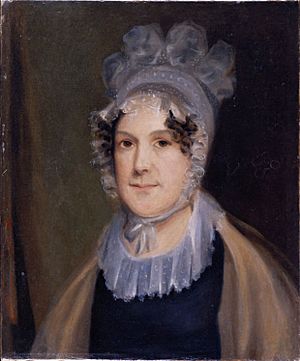
Jefferson described Martha as the "cherished companion of his youth and the nurse of his old age." Before he died, he said the "last pang of life was parting with her." Thomas Jefferson died on July 4, 1826, at age 83. After his death, Martha inherited Monticello from her father in 1826. She also inherited his many debts. Her oldest son, Thomas, managed the estate. Except for five enslaved people freed in her father's will, and "giving her time" (informal freedom) to Sally Hemings, the remaining 130 enslaved people at Monticello were sold. This was done to try and pay off the debts.
Martha put Monticello up for sale two weeks after her father died. She tried to sell it through a lottery. But she could not sell it until 1831. It was sold for $7,000, which was only one-tenth of its value.
She had little income from her father's estate. She lived "on the edge of poverty." She wanted to make sure her family had good careers. She looked to Margaret Bayard Smith for help. Margaret helped family members get jobs in Washington. For example, Nicholas Trist, her son-in-law, got a job with Henry Clay.
After Jefferson's death, Martha lived with her oldest son, Thomas, at Tufton. She stayed with her daughter Ellen and son-in-law Joseph Coolidge in Boston from October 1826 to May 1828. She had her two youngest children with her. She then went to her husband in June 1828. She was with him when he died on June 20.
After her husband's death, she lived with her son at Edgehill estate. Then she lived in Washington, D.C. and Boston with her other married children. To earn money, she hired out the enslaved people she still had. She also received money from bank stock. The states of Louisiana and South Carolina each gave her $10,000 to support her.
Her unmarried daughters, Mary and Cornelia, started a school at Edge Hill. Martha sometimes taught music there. Martha also traveled to visit her married children in her later years.
While in Boston, Martha wrote her final will on January 24, 1836. She returned to the Edge Hill estate in July 1836. She died there on October 10, 1836, at age 64. She was buried at the Monticello family graveyard.
Martha's Views on Slavery
Martha's grandfather had two families. One was with Martha Epps. The other was with an enslaved woman named Betty Hemings. Betty's children were owned by the family. In 1773, Martha inherited 135 enslaved people when her grandfather died. This included her half-aunts and uncles from the Hemings family. She also inherited 11,000 acres of land. At Monticello, Sally Hemings (also a granddaughter of John Wayles) raised her children with Thomas Jefferson.
When Martha lived in Paris, she learned that some countries did not allow slavery. She told her father, "I wish with all my soul that the poor Negroes were all freed." She also said she "detested" the unfair treatment of Black people. She felt it made white people cruel. She tried to keep enslaved families together when she could. She also freed some enslaved people. But she had to sell many others to pay off debts. For example, in 1827, after her father died, she sold 130 enslaved people. This caused families to be separated. The remaining enslaved people were her most valuable assets. She hired them out for income when she could. She sold two more enslaved people in 1833. She also punished enslaved people who did not do what she wanted. Sometimes this was physical. In 1833, Martha's daughter Cornelia wrote about a time when she held a woman down while her mother whipped her "pretty severely."
Her son Thomas tried to get Virginia to slowly end slavery and send enslaved people to Africa in 1831. Martha supported this idea. She also thought about moving to a free state. Even though she freed some enslaved people in her will, she relied on their work throughout her life.


